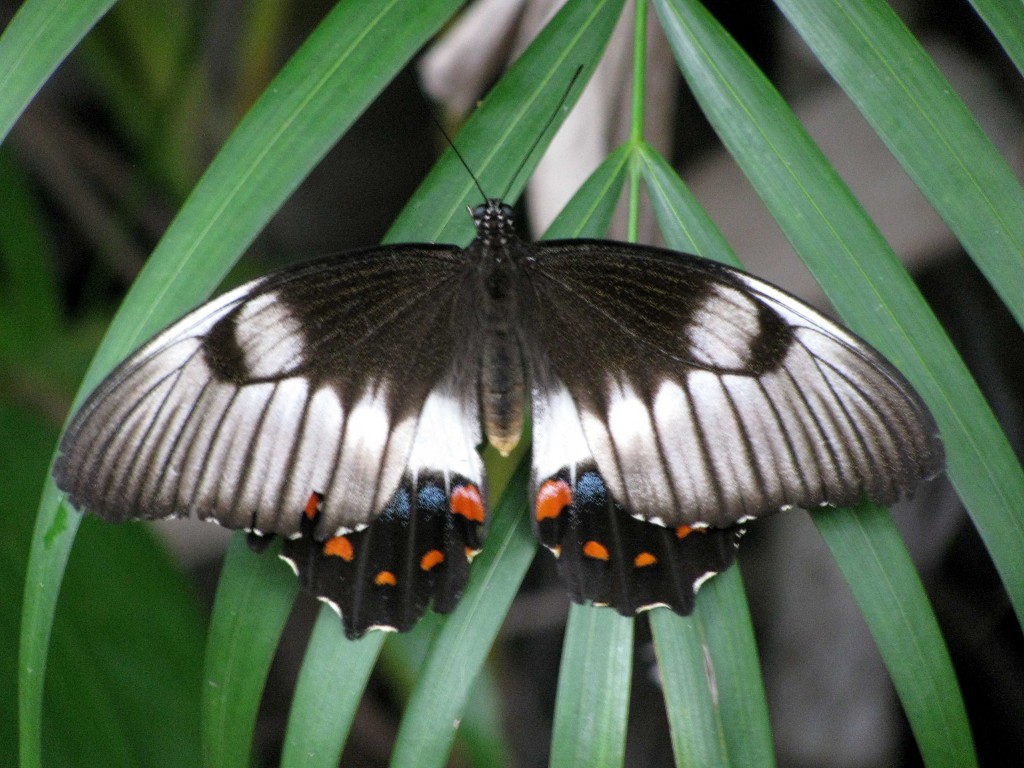While working at my desk facing a window with a view out into the rather tangled vegetation of our yard, I have, over the three months we have so far resided in Rosslea, been distracted by many things – skinks racing up the trunks of palm trees, drenching sheets of white rain during the Wet, birdlife – mostly notably a gorgeous male yellow-bellied sunbird – and butterflies. This afternoon, I became almost dizzy from repeatedly leaping up from my chair to race out into the yard with camera in hand to try to capture butterfly images, a process necessitating a change from my computer glasses to my regular glasses, and then back again upon my return to my desk. The sun and calm air had brought the butterflies out in droves – magnificent black and blue Ulysses swallowtails, huge, emerald and black Cairns birdwings, orchard swallowtails, blue tigers with their streaks of dark brown and pale blue, clear-winged swallowtails, and others I have yet to identify.

Female Orchard Swallowtail (© Magi Nams)
While pursuing my butterflies, I thought of Henry Bates in the Amazon collecting 14,000 species of animals, 8,000 of which were new species and many of which were butterflies.1 Had he, during the eleven years he spent in the Amazonian rainforests during the mid-19th century,2 repeatedly leapt to his feet with a butterfly net in hand, intent on the pursuit and capture of glorious, scaly-winged insects?
Thinking of Bates brought to mind Charles Darwin, yet another of England’s famous naturalists who traveled the world in the 1800’s, and who subsequently turned the scientific and religious worlds upside down with his theory of evolution by natural selection. Darwin, during his five-year exploratory stint on the Beagle,3 paid a two-month visit to Australia, during which he observed kangaroo rats, platypuses, blue-tongued lizards and other Australian fauna and collected specimens from the Sydney, Hobart, and Albany areas.4 During a horseback excursion across the Blue Mountains, he observed Aboriginal people – already greatly in decline in 1836 due to the British invasion – and wrote, “The varieties of man seem to act on each other in the same way as different species of animals – the stronger always extirpating the weaker.”5 Darwin was a poor sailor, and I, after experiencing the sauna atmosphere of a North Queensland summer, can more closely relate to his comment regarding the Beagle’s crossing of the equator, during which the young naturalist was laid up in his cabin due to seasickness and wrote in his diary that it was as though he “was being stewed… in warm melted butter.”6
In late afternoon, Vilis and I attended a talk at the Reef HQ Aquarium given by Chris Darwin, the great, great grandson of Charles Darwin. Titled ‘Darwin Descendant Drops In,’ the talk included a variety of topics, including the current C. Darwin’s passion for rock climbing in the Blue Mountains, the paradigm shift regarding climate change that he thinks is necessary to save the Great Barrier Reef, a discussion of developing the ability to think in a strong, rational way, and of course, his illustrious ancestor’s passion for creation, inquiring mind, and eventual proposal of the theory of evolution by natural selection.
Presented in a lively, attention-grabbing style, the whole talk was entertaining and stimulating, yet the one piece of information that stuck with me was the fact that Chris Darwin had fundraised $300,000 in order to address his great, great grandfather’s one regret, that being that Charles Darwin wished he had done more to care for his fellow creatures. The younger Darwin gave the money to Bush Heritage Australia, which used it to purchase a 69,000-hectare former station located in southern Western Australia. In 2003, that semi-arid former grazing land and biodiversity hotspot within the apparently world-famous Southwest Botanical Province became the Charles Darwin Reserve.7 It’s home to salmon gums and York gums, heaths and sand plain vegetation, red kangaroos, echidnas, and Major Mitchell’s cockatoos,8 to name a few inhabitants. I recalled the pair of bushwalkers Vilis and I met in Tallangatta, Victoria, who suggested we visit the southwest of Western Australia because its plant life is brilliant. Vilis is thinking about attending another conference, either in Canberra or in Perth. My vote is for Perth, away down in the southwest of Western Australia. I want to see that biodiversity hotspot, with its rare but now protected species.
References:
1. Sean B. Carroll. 2009. Into the Jungle: Great Adventures in the Search for Evolution. Pearson Education, Inc., San Francisco. p. 54-55; 2. Ibid, p. 53; 3. Ibid, p. 12.
4. ABC Radio National, Ockham’s Razor, 11 January 2009. Charles Darwin in Australia. Host: Robyn Williams. Guest: Frank Nicholas, author (along with Jan Nicholas) of Charles Darwin in Australia, Cambridge University Press. Accessed 29-Apr-2010. http://www.abc.net.au/rn/ockhamsrazor/stories/2009/2445196.htm
5. Quoted in: Geoffrey Blainey. 1994. A Shorter History of Australia. Vintage Books Australia, North Sydney. p. 50.
6. Quoted in: Carroll, p. 13.
7. ABC Rural, Bush Telegraph Summary, Bush Telegraph 27/05/2003: Charles Darwin Reserve. Accessed 29-Apr-2010. http://www.abc.net.au/rural/telegraph/stories/s865274.htm
8. Wikipedia. Charles Darwin Reserve. Updated 24-Sep-2009. Accessed 29-Apr-2010. http://en.wikipedia.org/wiki/Charles_Darwin_Reserve


